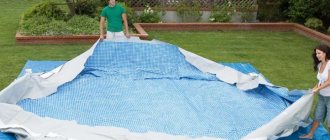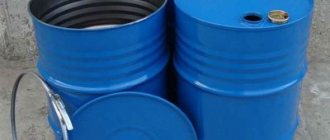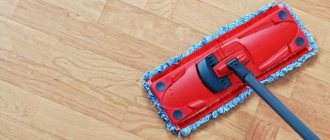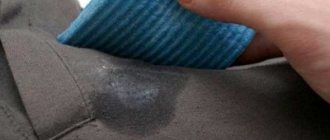The dacha pond is designed for a pleasant pastime. Leaves and dust settle on the walls, and the water becomes favorable for the growth of bacteria. To maintain cleanliness, it is necessary to wash the frame pool using mechanical or chemical treatment.
Stagnant water blooms under the influence of ultraviolet radiation and algae forms in it
Why do you need to wash a frame pool?
A country pond is often installed in an open area. Therefore, leaves, dust, sand, soil, and insects accumulate on the surface of the water and the bottom of the bowl. The pool and the upper layer of the epidermis, hair, and remnants of bathing cosmetics pollute the pool.
The sun's rays warm the water and promote the development of bacteria. The reservoir is cleaned of:
- garbage;
- mold;
- microorganisms;
- fungus;
- rust;
- alkaline precipitation.
Swimming in a dirty pond is not only unpleasant, but also unhygienic. This may lead to skin or other infections. Therefore, periodic cleaning of the frame pool with your own hands is required.
Which is better: Chlorine or peroxide
- Peroxide, unlike chlorine, does not cause such severe harm to human health. Chlorine vapors can have a negative effect on human mucous membranes and irritate them.
- Chlorine is more effective. It cleans and disinfects much better and can even kill E. coli.
- Peroxide as an oxidizing agent is about 30% stronger than chlorine.
- Chlorine acts much faster, while peroxide acts for about two days.
So what is the best way to process it? The best solution in such a situation would be to alternate these funds.
How to clean a frame pool
You can clean the frame pool bowl from any type of contamination using mechanical, chemical and electrophysical methods. The methods differ in labor costs and financial investments in electrical appliances or chemicals.
How to wash a frame pool after draining the water
A brush, active foam and a washing vacuum cleaner cope with any dirt. The mechanical method of cleaning the bowl is carried out:
- foam and brush to remove stains, fungus, plaque, rust;
- a net for collecting garbage;
- telescopic brushes and rods for cleaning the bottom.
Tips from the video will help you clean the bottom of a frame pool:
How to clean a frame pool from black deposits
The electrophysical method is suitable for cleaning surfaces. Modern filters purify water well, but dirt remains on the walls and bottom. Experts recommend using vacuum cleaners. Frame pools are cleaned at home by:
- A hand-held vacuum cleaner, which consists of a handle bar, a corrugated hose and a brush. It is connected to the filtration station. Use a brush to sweep along the walls and bottom. The filtration station draws in waste and water, passes it through the purification system and delivers the already purified liquid into the reservoir. To constantly keep the pool clean, the procedure is performed every two days.
- A semi-automatic underwater vacuum cleaner is used to clean the reservoir bowl. The robot moves along the bottom and sucks in debris. The telescopic brush has been improved and allows you to more conveniently adjust the length and position of the handle.
- An automatic submersible vacuum cleaner collects litter without human intervention. Its operation is controlled using a remote control, sending it to the most contaminated places.
If the water is still clear, but debris is floating, the easiest way to clean it is with a net or vacuum cleaner.
Filtration and circulation of water do not exclude chemical disinfection, since they do not kill bacteria. Chlorination eliminates nitrogenous compounds and viral microbes. Disadvantage: emits a strong unpleasant odor, dangerous to human health.
Bromine is not a very effective and expensive substance. Is poison. Oxygen is safe for humans, but does not cope well with viral bacteria. To quickly disinfect a pond, add a double dose of chemicals and leave the reagent to work for 24 hours.
Attention! Cloudy water with a green or milky tint indicates the development of bacteria and algae. It is during the interaction of chlorine and these trace elements that an unpleasant ammonia odor is released.
Algae can be eliminated only by algaecides. Restoring water clarity does not mean the destruction of bacteria and fungi. Only chemical disinfectants can kill these microorganisms.
other methods
Silver ions
Thanks to ionization with non-ferrous metals, the need for water disinfection with chlorine can be reduced. There is no smell after cleaning. If a person has a large swimming pool, then it is recommended to use chlorine, which is a common method. Ionization systems do not combine well with other disinfection systems, and silver ions do not destroy all types of microbes. The effect of silver ions is that the ions interact with bacterial cells, metabolic disorders occur, and they die . However, it has now been proven that silver ions have a negative effect on the body.
Active oxygen
Active oxygen is very popular because it effectively and gently destroys bacteria and does not form harmful decay products. It is expensive and decomposes very quickly in water, which requires increasing the dose during subsequent purification. An overdose of this substance can lead to health problems. Active oxygen cannot be used in public or outdoor swimming pools. Warm pools with temperatures above 28 degrees are also not suitable for treatment, because oxidation slows down in warm water. After treatment there is no chlorine smell.
Ozonation
It is considered an environmentally friendly but expensive cleaning method. Used in addition to chlorination. Thanks to this method, the water is purified and also acquires a pleasant taste and smell. The water begins to acquire a blue tint and foam does not form. However, if high concentrations of ozone are inhaled, damage to the respiratory tract and lungs occurs. Pure ozone can explode and does not last long. When used correctly, ozone does not cause irritation to the skin, but in the environment it combines with air and is therefore neutralized. It is mainly used in large public swimming pools because it requires the installation of complex equipment. This cleaning system pays for itself in several years, because there is a saving in chemical costs.
In addition, you can use bromine or ultraviolet lamps.
How to clean water in a frame pool at the dacha
Summer residents often make a handheld vacuum cleaner with their own hands, which is connected to a filtration station. Take a brush from a regular vacuum cleaner, place it on a plastic flexible corrugated pipe and connect it to the filter.
The filter does not collect plaque, which settles on the walls and bottom of the bowl. A vacuum cleaner helps eliminate it.
Filters are sand, cartridge, diatomaceous earth
The sand filter is filled with quartz sand. It collects debris down to 20 microns. The filter is cleaned when it becomes dirty under running water.
A cartridge filter is a more powerful piece of electrical equipment. Detains debris up to 10 microns.
Diatoms collect debris up to 3 microns in size. The downside of the installation is that the cartridge gets clogged quickly and is replaced several times during the season.
The children's inflatable pool is cleaned using the vacuum method: a hose with a brush is placed in the bowl. Air is drawn in from the other end to allow water to flow out. Run a brush along the bottom to draw in debris.
Organizing water exchange allows you to do without chemicals. The essence of the method is to add 0.5% water daily. The contaminated liquid is poured into the garden to water the beds, and fresh, clean water is added to the required level.
Cleaning a frame pool after winter is done in the spring, when the weather returns to normal and no return frosts occur. If the reservoir has undergone comprehensive cleaning in the fall, then the procedure will be minimal. Collect garbage, wipe dusty walls with a brush, and rinse with water. The walls are coated with an antifungal drug, the bowl is filled, shock disinfection is carried out with chemical reagents, and the substance is left to work for three days.
If cleaning was not carried out in the fall, or the container became filled with dirt during the winter, do a thorough cleaning. The bowl is treated with active foam, thoroughly rubbed into the walls and bottom. They are washed with water, treated with an antibacterial agent, filled with water and disinfected.
Errors
Cleaning the pool from white stains using household chemicals does not give the desired effect. The consumption of such chemicals will not be economical at all. Also, folk remedies are not always effective - in case of severe damage to the walls by mineral deposits, citric acid and vinegar will not be able to dissolve the plaque.
The consequences may be insufficient cleaning and sanitization of the walls and bottom, which significantly shortens the life of the pool and has a detrimental effect on the structure.
Despite the laboriousness of the procedure, pool owners are strongly advised not to delay cleaning the pool using chemicals.
To correct errors, you need to follow the recommendations of pool cleaning specialists and carefully study the instructions. You can drain the water, thoroughly rinse the pool of previously used chemicals, and dry the surface.
How to wash a frame pool
When cleaning a reservoir, take into account its size, what material it is made from, and the degree of pollution. The cleaning agent for a frame pool is selected taking into account the safety of children. Inventory that may be useful:
- brush;
- vacuum cleaner;
- disinfectant;
- filter station;
- mini washer.
When choosing a disinfectant, pay attention to the composition, expiration date and active ingredient. Manufacturers have also begun to produce products that cope with any type of pollution. Cleaning steps:
- The water is drained.
- They remove the garbage.
- A cleaning agent for frame pools is applied to the walls and bottom. The drug is dosed strictly according to the instructions indicated on the package.
- The reagent is left to work for 30 minutes.
- Use a brush or mini-wash to remove dirt.
- Rinse thoroughly with water and repeat the procedure (steps 3-5).
- For winter preservation, leave until completely dry, collect and put away for storage.
- If the cleaning is preventive, the walls and bottom are treated with an antimicrobial agent, filled with water, and disinfected. Leave for 1-3 days.
Timely preventive cleaning extends the life of the reservoir. A properly organized procedure for wintering will allow you not to waste time on the bowl in the spring.
How to clean a frame pool without draining the water
A sand filter is included with the frame pool. It has low productivity, so summer residents purchase more powerful units. Electrical appliances will help you wash the inside of a frame pool without chemicals.
Experts recommend cleaning bowls that are too dirty with the help of professionals.
Full-spectrum disinfection chemicals have proven themselves reliably. Manufacturers produce powder, liquid and tablets.
Experts recommend connecting electrophysical preparations according to the instructions. If necessary, methods of cleaning a reservoir are combined. For example, a disinfectant is poured into a skimmer, which passes water through a filter, and the disinfection process occurs faster.
How to clean a frame pool from fungus
If the pond has acquired a black tint, it means that it has been infected by a fungus. Chemical and mechanical cleaning methods will effectively combat this type of pollution. Process:
- The water is drained and the rubbish is removed.
- Apply a chemical cleaning agent. The seams are carefully processed.
- After complete absorption of the drug, remove dirt from the surfaces of the bowl with a brush.
- Thoroughly wash the walls and bottom.
Chemicals remove limescale, algae and regulate water clarity.
Attention! When working with chemicals, you should remember to protect yourself. Use goggles, rubber gloves, protective clothing or an apron.
Cleaning from corrosion
Often tap water contains a lot of iron. Therefore, it can acquire a brownish rust color and form a dark sediment after draining the liquid. Swimming in such water is completely uncomfortable and can also harm the mucous membrane. You can clean the liquid from corrosion using coagulants - organics. For example, hydrochloride or synthetics based on Al, Fe sulfates.
They combine with Fe, then settle in the form of large flocculent formations that are captured by filter units. But initially, before adding coagulants to the liquid, experts advise measuring and, if necessary, normalizing the pH. The normal value should be in the range of 7.3–7.5. To determine pH, modern pH meters or test strips are used. It is recommended to measure every week, after the next addition, as well as when sediment appears.
Keeping your own swimming pool in a well-maintained condition in a country house is a difficult task. But modern technologies are ready to offer a huge selection of products for high-quality pool cleaning. The main thing is not to make mistakes when choosing, to select the appropriate equipment and methods, taking into account the type of reservoir and its workload by the people who operate it. Health depends on proper care.
How to purify water in a frame pool
The reservoir is polluted every day. Therefore, cleaning is carried out periodically. Handy tools that help remove dirt:
- remove surface debris with a net;
- brushes for cleaning the sides and bottom with a telescopic handle;
- a vacuum cleaner helps remove sediment and green deposits from the bottom;
- the filtration station forces water through the filter so that the liquid remains clear;
- a rotary machine using chemical reagents allows you to thoroughly clean the bottom;
- The water pump removes dirt with chemical solutions immersed inside the bowl.
Mechanical cleaning
The cleaning option involves the use of hand tools. Suitable for removing debris from surfaces. But this method is not used to remove germs and bacteria. Among the devices that can be used are:
- Brushes to remove leaves, branches and debris;
- Nets that can be used to remove debris and foam formed by flowering;
- Vacuum cleaner for removing dirt from the walls and sand and dirt from the bottom.
This is the most popular method of putting a pond in order. It is carried out at least every other day.
How to maintain clean water in a frame pool
It is difficult to eliminate all types of contaminants at once, so various methods are used in combination. A vacuum brush helps clean the walls of a frame pool from plaque, and chemicals help eliminate bacteria. Tips for keeping your pool water clean:
- after each bath in the evening, start the filter unit;
- it is important to monitor the normal pH level of the water so that the action of the reagents is effective;
- before visiting the pool, cleanse the skin of cosmetics and take a shower;
- once a week requires water renewal of 0.5%.
Maintaining acceptable acid-base balance
An acceptable balance is 7.2 – 7.4, not 5.5. It is necessary to remember this and diligently maintain the required regime in the water.
Analysis of the water that fills the pool can be carried out using special chemical reagents. Any of them is freely available, each of them is accompanied by mandatory instructions.
If you have doubts about the use of reagents, it is worth remembering that they are the ones who guarantee the normal use of the water filtration system, its lighting and heating systems.
And an acceptable acid-base balance improves the quality of the effects of chemicals used in the process of water purification.
For example, today it is recommended to purchase special pumps for cleaning, with additional containers installed inside, filled with the necessary coagulant, which guarantees normalization of the pH level.
It is better to purchase just such filters, although their cost is somewhat higher. But the benefits from their influence are incomparably greater.
Electrophysical cleaning methods
This is another potential answer to the question of how to clean a pool. In this case, flow-through disinfectors are built into the circuit. The most popular cleaning devices include several types: UV filters, ozonizers, chlorinators and chlorine-free systems.
UV filter
This is a small chamber through which water is drawn into the reservoir. The liquid is disinfected under the influence of an ultraviolet lamp, so the activity and growth of microorganisms is completely blocked. This type of cleaning is effective and absolutely safe for people. Moreover, the result does not depend on the pH value (pH level) of the liquid.
Using an ozonizer
The operating principle of this device is the creation of ozone molecules that break down into oxygen and water. This method is now used very often, the reason is its maximum efficiency. The devices purify and clarify water, eliminate unpleasant odors, and quickly break down unsafe compounds. Ozonation is considered one of the most promising areas for use in water treatment plants.
Help of drugs with bromine
This chemical element does not change the pH of the liquid, it is not allergenic, and does not irritate the skin and mucous membranes. However, bromine is effective against microorganisms and algae, and, like chlorine, removes organic contaminants. But it cannot cope with a large volume of work, so it is used together with a chemical “colleague”. The second disadvantage of products containing bromine is their higher price. These products are also produced in the form of powder and tablets.
Other drugs
It must be said that the simplest means do not always cope with their task. Therefore, owners have to consider other options.
If a lot of dirt has accumulated and the liquid is very cloudy, then it makes sense to use other means - coagulants and flocculants. These drugs are able to bind particles, after which they precipitate to the bottom of the pool. Such contaminants are collected with a vacuum cleaner. Examples - AquaDoctor, Aqualeon, Bayrol Quickflook Super, Chemoform Flokfix, Melspring Melpool DualFloc Bio, AquaSTART.
Algaecides are reagents that help cope with mold and algae and prevent their reappearance. Therefore, regular treatment of the pool with these preparations is protection against vegetation and the appearance of silt deposits. Popular algaecide preparations are Aqualand, Algitinn, Chemoform Alba Super K, Maxisan-algaecide, Super-Pul.
Complex preparations can be used for disinfection. Their bases are bromine, chlorine, and organic acids. True, their price is higher than that of simpler analogues: they often cost twice as much.











